Puzzling over Memory

Warm Up: Drawing from Memory
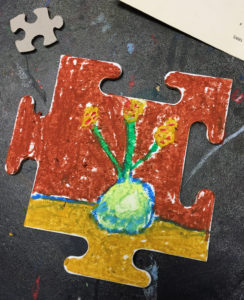
A Student’s Warm Up Piece

Warm Up Example
In the second workshop, I introduced the idea of the relationship between memory and the metaphor of a puzzle in a medium of choice such as painting or drawing with oil pastels. The students started off with a warm up where they chose a postcard from a box with many intriguing art images, studied their picture for one minute, put it away and then drew or painted on a puzzle piece from their memory of the postcard. After the slides of artists working with memory, I demonstrated painting techniques that applied to memory such as layering through glazing, scumbling, wet on wet and rub out. They then made a painted or drawn memory on a pre-made puzzle on the back or by cutting their own puzzle on tagboard. At the end, they gave it a title and we had a gallery walk to admire others’ work and give a positive comment.
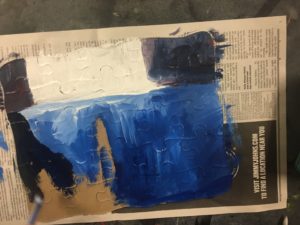
Starting Little Moon

Little Moon, Student’s Piece

A Girl’s Drawing of a School Experience
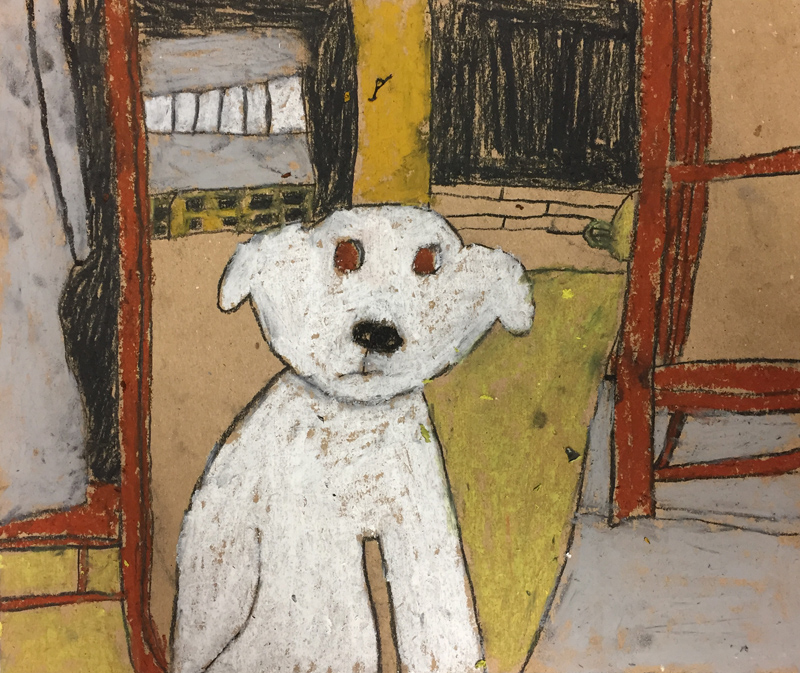
A Beautiful Example of a Student’s Memory
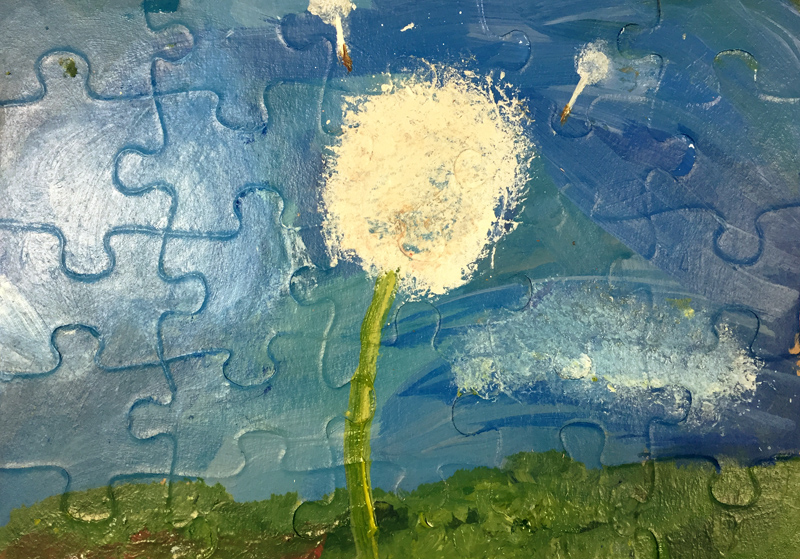
A kid’s memory of an experience she had outdoors

Student Title: Freedom and the Ways to Find It.

Student Title: The Farm
_____________________________________________________________________________
Secondary Art Methods: Lesson 2
Tessa Sutton
Spring 2019
Title of the Workshop: Puzzling over Memory
Level or Course: Secondary (grades 7-12)
Time Needed: 90 minutes
Overall Goals:
Big Ideas: Exploring memory through sense perception, linking painting techniques to the concept of recollection, personal history, self-expression
Description & Purpose:
Working with a memory, how can you paint it similar to the characteristics of memory itself as something that appears and disappears, sticks in your mind, or is fragmented? How can the concept of the moving parts of a puzzle be related to your ideas of memory?
Importance:
Multitudes of artists have been engaged with the phenomenology of perception, including memory as part of human experience, through sense perception. Memory inherently involves time and personal history, experiences that lend themselves well to exploration through painting.
Art Concepts/Technical Skills:
Students will probe their memories and translate them into the medium of paint through the metaphor of a puzzle. Students can choose to paint their images before they create an abstraction of the pieces and cut the puzzle, or make the puzzle pieces before and then paint afterwards in order to play with the concepts and materials more thoroughly.
NAEA Standards:
- Creating: Organize and develop artistic ideas and work, anchor standard #2.
- Presenting: Convey meaning through the presentation of artistic work, anchor standard #6.
- Responding: Interpret intent and meaning in artistic work, anchor standard #8.
- Connecting: Synthesize and relate knowledge and personal experiences to make art, anchor standard #10.
Objectives:
- TLW experiment with strategies to experiment with the form and metaphor of a handmade puzzle in relation to memory, anchor standard #2.
- TLW develop a title for their piece to be viewed by peers in a display at the end of workshop, anchor standard #6.
- TLW observe and critique artworks shown in the slides by drawing conclusions from the images and supporting these ideas in a discussion with peers, anchor standard #8.
- TLW consider their personal phenomenology of memory and perception by exploring abstract and figurative images through paint, anchor standard #10.
Visuals:
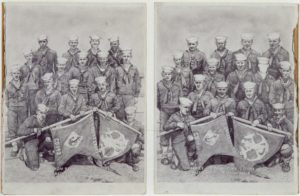
Colter Jacobsen, pencil on paper, (no title).
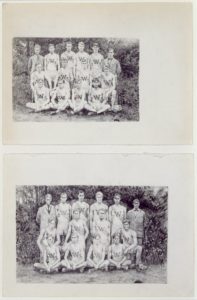
Colter Jacobsen, graphite on paper, (no title).

Ekaterina Panikanova, Errata Corrige #2, mixed media, 130 x 110 cm., 2012.

Ekaterina Panikanova, Pars Particularis, mixed media, 140 x 120 cm., 2014.
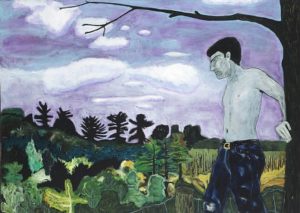
Peter Doig, At the Edge of Town, oil on canvas, 59.8 x 83.8 in., 1986-88.

Peter Doig, Fisherman Boys, archival print of his painting, 64 x 86 in., 2013.
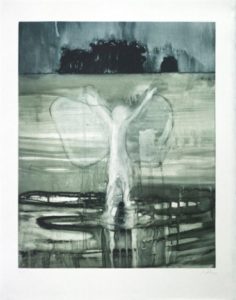
Peter Doig, Paragrand 2, aquatint etching, 20 x 16 in., 201

Teacher Example: Backyard Archaeology with Ginkgo Leaves, gesso, acrylic on tag board, dimensions variable, 2019.
Vocabulary:
Abstraction: the process of considering something independently of its associations, attributes, or concrete accompaniments.
Concealing: to place out of sight.
Depth: the degree of intensity going into space in a visual sense.
Fragmentation: the process or state of breaking or being broken into small or separate parts.
Glazing: a technique in painting where a layer of medium and paint are applied over another layer of paint that shows through; transparent paint layers.
Memory: the faculty by which the mind stores and remembers information or something remembered from the past; a recollection.
Perception: the ability to see, hear, or become aware of something through the senses; a way of regarding, understanding, or interpreting something; a mental impression; intuitive understanding and insight.
Phenomenology: Phenomenology is the study of structures of consciousness as experienced from the first-person point of view. The central structure of an experience is its intentionality, its being directed toward something, as it is an experience of or about some object.
Shape: the visible makeup characteristic of a particular item or kind of item.
Supplies, Materials and Resources Needed:
Book board or other semi-thick hardboard (1/8 inch or less), sample puzzle pieces, gesso, large brush for gesso, acrylic paint, gel medium, drawing paper, scissors, exact-o knives, tape, pencils, erasers, cutting mat, paint, trays, water cups, water from sink, brushes, paper towels, aprons if needed, newspapers, puzzle examples, a fan to dry to paintings, postcards, fan to dry paint.
Technology: Computer, monitor, HDMI or other cables to attach computer to monitor
TEACHING PROCEDURE PLAN
A. Launch: (Total 5 min.)
1. Students choose a postcard from a pile offered and study the image carefully for one minute. (30 seconds
2. After that minute, they hide the picture and try to paint as much as they remember on the teacher provided puzzle piece that has been gessoed, adding details especially and including any color. (4 min.)
3. Then they compare what they have drawn to the image on the card. This is to show them how visual memory is reconstructed through their senses when the object is removed from view, and how selective our memory is. (30 seconds)
B. Instruction or Demonstration with Problem: (Total 10 min.)
4. Students will be given manufactured puzzle pieces to play with and first think about the idea of memory in relation to this form and what it could mean and turn and talk with a partner about their ideas. (1 min.)
5. Teacher will explain that they will be making a puzzle about their memories and the various approaches they could possibly take such as painting their piece first, then cutting apart or playing with cutting shapes and then painting them afterwards. (1 min.)
6. While students are exploring, instructor will show slides of the artists Colter Jacobsen, Peter Doig and Ekaterina Panikanova, and discuss with them about how they create meaning under the concept of memory through materials and form. (5 min.)
7. Instructor will demonstrate scumbling (paint dragged loosely over the top with a bristle hair brush), layering through glazing (with gel medium), wet on wet and using a rag/paper towel in painting techniques to show how these can be part of their concept, such as layering, disappearance and fragmentation. (3 min.)
C. Create: (Total 65 min.)
8. Students will be informed of the location of materials in the room available to use and are free to ask to use other mediums. (1 min.)
9. TLW be asked to gesso their boards if they want to paint first and then cut it up. If they do not wish to paint first, they do not have to gesso until after they cut up the pieces. (1 min.)
10. TLW compose three thumbnails of size of their choice with paint or pencil, to think visually about their memory in possible puzzle shapes or just their image. (5 min.)
11. TLW create an image from one thumbnail (originally from a photograph or just in their mind for reference) and convey this through the paint and book board materials in some form of a puzzle. (53 min.)
12. Clean up will consist of students cleaning their areas and placing materials back where they belong. (5 min.)
D. Closure: (Total 10 min.)
13. In a final exhibition view, students will arrange their pieces on the tables along with their title and discuss the meaning of the work, share their process and determine what was successful among the work of their peers.
Questions to ask students to engage them in a discussion of their art:
“From the images in the slides, do you have new ideas or techniques about how to approach making your puzzle?”
“What part of memory do you want to talk about? Is it the fleeting sense of it, the presence of someone or maybe the brightness of the colors?”
“What painting techniques can you use to feel out your memory?”
“Did you discover anything about the concept of memory and how you made it?”
“How old were you in your memory and how did that feel? What were you doing?”
Rubric/Assessments/Evaluation/Feedback:
Formative/Informal:
Questions:
“How will you tie together the puzzle shapes with your image? How do they connect?”
“Does your painting technique change from your first idea to when you started making it?”
“What title will you use in your piece and how does it relate to the idea of a puzzle or how you painted it?”
“Are you letting yourself play with the materials before you begin your final piece? Maybe your final piece is just playing with fragments?”
Observations:
Teacher will circulate around the room and see if students are experimenting with puzzle shapes and images together. Teacher will also see if they understand how painting techniques can affect the meaning of their memory.
Summative/Formal:
Students will discuss their work in a final display after titling their pieces and placing them on tables for others to observe and discuss. They will talk about how their techniques and materials influenced their resulting memory piece as well as their material and conceptual process.
Accommodations, Enrichments & Extensions:
Students who may have difficulty with this lesson:
Accommodations can be made for students who have trouble holding or grasping materials by creating a sponge for them to put their brush or pencil inside of. Anyone who needs assistance with exact-o knives can be aided. People who have difficulty cutting can use pre-made puzzle shapes given by the instructor. Students who are hard of hearing may sit nearer to the instructors as well as sight impaired students. Presentations will have large font for people at the back to see clearly.
Advanced Learners:
Students can make more complex shapes or 3-D puzzles that they construct through experimentation.
Students who finish early:
Students can play with their puzzles and share with others who are also finished. They can also make a smaller, second puzzle.
References:
Barthes, R. (1980, 2000). Camera Lucida. Vintage Classics, Random House: London, UK.
Doig, P. (1988, 2013). At the edge of town; Paragrand 2; Fisherman Boys. Artnet.
Retrieved from www.artnet.com/artists/peter-doig/.
Jacobsen, C. (2019). Colter Jacobsen. [Website]. Retrieved from https://www.colterjacobsen.com.
Merleau-Ponty, M. (1964). The Primacy of Perception. Evanston, IL: Northwestern University.
Panikanova, E. (2012). Errata corriga #2; Pars particularis. Sara Zanin Gallery.
Retrieved from http://www.z2ogalleria.it/ekaterina-panikanova/.
Sebald, W.G. (2001, 2011). Austerlitz. Random House: New York, NY.